Exhibitions
2016-1 MOMAT Collection
Date
-Location
Art Museum Collection Gallery
The collection exhibition from May 24 to August 7, 2016
Welcome to the MOMAT Collection! Here are a few things to keep an eye out for in this edition. First of all, in the “Highlights” section (Room 1, 4th floor), be sure and see Tsuchida Bakusen’s Serving Girl at a Spa (Important Cultural Property) and Kaburaki Kiyokata’s Boating Excursion on the Sumida River, two works that are perfectly suited to the summer. And don’t miss the various other works that eloquently express a wide range of emotions related to the season. For example, when you take a close look at the various devices painters used to depict light (Room 2, 4th floor), and rain and atmosphere (Room 10, 3rd floor), you are sure to feel an even deeper attraction to these works.
Last year the museum acquired 11 works by the oil painter Matsumoto Shunsuke, who was active during and after World War II. These new acquisitions are on view along with a number of Matsumoto’s paintings that were already part of the collection in Room 6 (3rd floor) and Gallery 4 (2nd floor).
In Gallery 4, we also present a small exhibit called Modern Landscapes – For the Pleasure of People and Scenery: Nara Yoshimoto Curates the MOMAT Collection. When seen through the eyes of noted artist Nara Yoshitomo, the works in this display promise to take on a new allure.
Finally, in conjunction with The Voice Between: The Art and Poetry of Yoshimasu Gozo exhibition, which will be held from June 7 to August 7 on the first floor, we present a selection of works by Wakabayashi Isamu, a close friend of Gozo’s, in Room 12 (2nd floor). This edition of the collection exhibit is once again filled with a great diversity of works. Please enjoy looking at them.
List of Exhibits
- Please note that the exhibits and the exhibition schedule are subject to change without previous notice. For up-to-date information, please kindly check our website.
| 展示場所(Shown on/at;Room No.) | 重文(Important Cultural Property) | 音声ガイド(Audio Guide) | 作家名 | 題名 | 制作年 (Year of Production; c.=~年頃) | 技法・支持体 | 収蔵経緯、寄贈、寄託(Mode of acquisition; Long term loan) | Name of the Artist | Title (in English) | Material (technique, support) |
|---|---|---|---|---|---|---|---|---|---|---|
| 4F (Fourth floor) | ||||||||||
| 1室 | 0062 | 靉光 | 眼のある風景 | 1938 | 油彩・キャンバス | 購入 | AI-MITSU | Landscape with an Eye | oil on canvas | |
| 1室 | 0019 | 鏑木清方 | 墨田河舟遊 | 1914 | 絹本彩色 | 文部省管理換 | KABURAKI, Kiyokata | Boating-Excursion on the Sumida River | color on silk | |
| 1室 | ◎ | 0020 | 岸田劉生 | 道路と土手と塀(切通之写生) | 1915 | 油彩・キャンバス | 文化庁管理換 | KISHIDA, Ryusei | Road Cut through a Hill | oil on canvas |
| 1室 | 0023 | 岸田劉生 | 麗子肖像(麗子五歳之像) | 1918 | 油彩・キャンバス | 購入 | KISHIDA, Ryusei | Reiko, Five Years Old | oil on canvas | |
| 1室 | 草間彌生 | 残骸のアキュミレイション(離人カーテンの囚人) | 1950 | 油彩、エナメル・麻布(種袋) | 購入 | KUSAMA, Yayoi | Accumulation of the Corpses (Prisoner Surrounded by the Curtain of Depersonalization) | oil and enamel on seed sack | ||
| 1室 | 39 | 佐伯祐三 | ガス灯と広告 | 1927 | 油彩・キャンバス | 文化庁管理換 | SAEKI, Yuzo | Gas Lamp and Advertisements | oil on canvas | |
| 1室 | 辰野登恵子 | Work 84-P-1 | 1984 | 油彩・キャンバス | 購入 | TATSUNO, Toeko | Work 84-P-1 | oil on canvas | ||
| 1室 | 田中敦子 | 作品 66 – SA | 1966 | ビニール樹脂・キャンバス | 購入 | TANAKA, Atsuko | Work 66 – SA | vinyl resins on canvas | ||
| 1室 | ◎ | 26 | 土田麦僊 | 湯女(ゆな) | 1918 | 絹本彩色 | 文化庁管理換 | TSUCHIDA, Bakusen | Serving Girl in a Spa | color on silk |
| 1室 | 奈良美智 | Harmless Kitty | 1994 | アクリリック・綿布 | 購入 | NARA, Yoshitomo | Harmless Kitty | acrylic on cotton | ||
| 1室 | ◎ | 17 | 萬鉄五郎 | 裸体美人 | 1912 | 油彩・キャンバス | 八木正治氏寄贈 | YOROZU, Tetsugoro | Nude Beauty | oil on canvas |
| 1室 | ジョルジュ・ブラック | 女のトルソ | 1910-11 | 油彩・キャンバス | 購入 | Georges Braque | Female Torso | oil on canvas | ||
| 1室 | ポール・セザンヌ | 大きな花束 | c.1892-95 | 油彩・キャンバス | 購入 | Paul Cézanne | Grand Bouquet of Flowers | oil on canvas | ||
| 2室 | 赤城泰舒 | 白い砂 | 1912 | 水彩、鉛筆・紙 | 赤城輝子氏寄贈 | AKAGI, Yasunobu | White Sand | watercolor and pencil on paper | ||
| 2室 | 大久保作次郎 | 三月の日 | 1917 | 油彩・キャンバス | 大久保婦久子氏寄贈 | OKUBO, Sakujiro | A Day in March | oil on canvas | ||
| 2室 | 太田喜二郎 | 田植 | 1916 | 油彩・キャンバス | 太田菊枝氏寄贈 | OTA, Kijiro | Rice-Planting | oil on canvas | ||
| 2室 | 川端龍子 | 慈悲光礼讃(朝・夕) | 1918 | 絹本彩色 | 文化庁管理換 | KAWABATA, Ryushi | Divine Light of Love: Morning, Evening | color on silk | ||
| 2室 | 34 | 徳岡神泉 | 蓮 | 1925 | 絹本彩色 | 徳岡房子氏寄贈 | TOKUOKA, Shinsen | Lotus | color on silk | |
| 2室 | 戸張孤雁 | 水面を眺める女 | 1914 | ブロンズ | 購入 | TOBARI, Kogan | Woman Gazing at the Surface of the Water | bronze | ||
| 2室 | 戸張孤雁 | 伊豆山の海 | 大正時代 | 紙本彩色 | 山本孝氏寄贈 | TOBARI, Kogan | Sea of Izusan | color on paper | ||
| 2室 | 中沢弘光 | 夏 | 1907 | 油彩・キャンバス | 文部省管理換 | NAKAZAWA, Hiromitsu | Summer | oil on canvas | ||
| 2室 | 中沢弘光 | まひる | 1910 | 油彩・キャンバス | 文部省管理換 | NAKAZAWA, Hiromitsu | Midday | oil on canvas | ||
| 3室 | 荻原守衛 | 文覚 | 1908 | ブロンズ | 購入 | OGIWARA, Morie | Priest Mongaku | bronze | ||
| 3室 | 12 | 荻原守衛 | 女 | 1910 | ブロンズ | 文部省管理換 | OGIWARA, Morie | Woman | bronze | |
| 3室 | 中原悌二郎 | 若きカフカス人 | 1919 | ブロンズ | 購入 | NAKAHARA, Teijiro | Young Caucasian | bronze | ||
| 3室 | 中村彝 | 自画像 | c.1912 | 油彩・キャンバス | 寄託 | NAKAMURA, Tsune | Self-Portrait | oil on canvas | ||
| 3室 | 中村彝 | 田中館博士の肖像 | 1916 | 油彩・キャンバス | 田中館美稲氏寄贈 | NAKAMURA, Tsune | Portrait of Dr.Tanakadate | oil on canvas | ||
| 3室 | 中村彝 | 静物 | 1917 | 油彩・キャンバス | 寄託 | NAKAMURA, Tsune | Still Life | oil on canvas | ||
| 3室 | ◎ | 29 | 中村彝 | エロシェンコ氏の像 | 1920 | 油彩・キャンバス | 大里一太郎氏寄贈 | NAKAMURA, Tsune | Portrait of Vasilii Yaroshenko | oil on canvas |
| 3室 | 柳敬助 | 白シャツの男 | 1914 | 油彩・キャンバス | 購入 | YANAGI, Keisuke | Man in a White Shirt | oil on canvas | ||
| 4室 | 荻原守衛 | 坑夫 | 1907 | ブロンズ | 購入 | OGIWARA, Morie | Miner | bronze | ||
| 4室 | 荻原守衛 | 女の胴 | 1907 | ブロンズ | 購入 | OGIWARA, Morie | Torso of a Woman | bronze | ||
| 4室 | 25 | 高村光太郎 | 手 | c.1918 | ブロンズ | 購入 | TAKAMURA, Kotaro | Hand | bronze | |
| 4室 | 戸張孤雁 | 唱える女 | c.1914 | ブロンズ | 購入 | TOBARI, Kogan | Woman Chanting Prayers | bronze | ||
| 4室 | 戸張孤雁 | 曇り | 1917 | ブロンズ | 購入 | TOBARI, Kogan | Cloudiness | bronze | ||
| 4室 | 戸張孤雁 | 煌めく嫉妬 | 1924 | ブロンズ | 購入 | TOBARI, Kogan | Glittering Jealousy | bronze | ||
| 4室 | オーギュスト・ロダン | トルソー | 制作年不詳 | ブロンズ | 岩波茂雄氏旧蔵、岩波雄二郎氏遺贈 | Auguste Rodin | Torso | bronze | ||
| 5室 | 伊藤廉 | パン | 1927 | 油彩・キャンバス | 作者寄贈 | ITO, Ren | Bread | oil on canvas | ||
| 5室 | 伊藤廉 | リューマチの労働者 | 1930 | 油彩・キャンバス | 作者寄贈 | ITO, Ren | Rheumatoid Labourer | oil on canvas | ||
| 5室 | 伊原宇三郎 | 室内群像 | 1928-29 | 油彩・キャンバス | 作者寄贈 | IHARA, Usaburo | Group in a Room | oil on canvas | ||
| 5室 | 伊原宇三郎 | バーモウビルマ国家代表像 | 1943 | 油彩・キャンバス | 無期限貸与 | IHARA, Usaburo | Portrait of Ba Maw, Burmese Premier | oil on canvas | ||
| 5室 | 梅原龍三郎 | 桜島(青) | 1935 | 油彩・キャンバス | 川口松太郎氏寄贈 | UMEHARA, Ryuzaburo | Mt. Sakurajima (Blue) | oil on canvas | ||
| 5室 | 59 | 梅原龍三郎 | 北京秋天 | 1942 | 油彩、岩絵具・紙 | 川口松太郎氏寄贈 | UMEHARA, Ryuzaburo | Autumn in Beijing | oil and Japanese pigment on paper | |
| 5室 | 梅原龍三郎 | 姑娘とチューリップ | 1942 | 油彩、岩絵具・紙 | 作者寄贈 | UMEHARA, Ryuzaburo | Chinese Girl and Tulip | oil and Japanese pigment on paper | ||
| 5室 | 梅原龍三郎 | 噴煙 | 1950-53 | デトランプ・紙 | 川口松太郎氏寄贈 | UMEHARA, Ryuzaburo | Volcano Mt. Asama Erupting | detrempe on paper | ||
| 5室 | 梅原龍三郎 | 葬壇 | 1977 | 油彩・キャンバス | 城下るり子氏遺贈 | UMEHARA, Ryuzaburo | Funeral Altar | oil on canvas | ||
| 5室 | 14 | 藤島武二 | うつつ | 1913 | 油彩・キャンバス | 購入 | FUJISHIMA, Takeji | Half Dreaming | oil on canvas | |
| 5室 | 藤島武二 | アルチショ | 1917 | 油彩・キャンバス | 購入 | FUJISHIMA, Takeji | Artichoke | oil on canvas | ||
| 5室 | 藤島武二 | 港の朝陽 | 1934 | 油彩・キャンバス | 東京国立博物館管理換 | FUJISHIMA, Takeji | Sunrise at a Harbor | oil on canvas | ||
| 5室 | 藤島武二 | 麻姑献壽(まこけんじゅ) | 1937 | 油彩・キャンバス | 武廣恭子氏寄贈 | FUJISHIMA, Takeji | Magu, a Nymph in an Ancient Chinese Legend | oil on canvas | ||
| 5室 | 安井曽太郎 | 黄色い甕 | 1912 | 油彩・キャンバス | 購入 | YASUI, Sotaro | Yellow Flower Vase | oil on canvas | ||
| 5室 | 51 | 安井曽太郎 | 奥入瀬(おいらせ)の溪流 | 1933 | 油彩・キャンバス | 文化庁管理換 | YASUI, Sotaro | Oirase Stream | oil on canvas | |
| 5室 | 52 | 安井曽太郎 | 金蓉(きんよう) | 1934 | 油彩・キャンバス | 購入 | YASUI, Sotaro | Portrait of Chin-Jung | oil on canvas | |
| 5室 | 安井曽太郎 | 安倍能成(よししげ)像 | 1944 | 油彩・キャンバス | 安倍恭子氏寄贈 | YASUI, Sotaro | Portrait of Mr. Abe Yoshishige | oil on canvas | ||
| 3F (Third floor) | ||||||||||
| 6室 | 藤田嗣治 | 哈爾哈(はるは)河畔之戦闘 | 1941 | 油彩・キャンバス | 無期限貸与 | FUJITA, Tsuguharu | Battle on the Banks of the Khalkha, Nomonhan | oil on canvas | ||
| 6室 | 松本竣介 | 山王の街 | 1933 | 油彩・板 | 購入 | MATSUMOTO, Shunsuke | The Town of Sanno | oil on board | ||
| 6室 | 松本竣介 | 黒い花 | 1940 | 油彩・板 | 購入 | MATSUMOTO, Shunsuke | Black Flowers | oil on board | ||
| 6室 | 松本竣介 | N駅近く | 1940 | 油彩・キャンバス | 購入 | MATSUMOTO, Shunsuke | Scene near N Station | oil on canvas | ||
| 6室 | 松本竣介 | 女の顔 | c.1946 | インク・紙 | 購入 | MATSUMOTO, Shunsuke | Head of a Woman | ink on paper | ||
| 6室 | 松本竣介 | 裸婦 | 1947 | 油彩・キャンバス | 購入 | MATSUMOTO, Shunsuke | Nude | oil on canvas | ||
| 6室 | 松本竣介 | ニコライ堂付近 | c.1947 | 油彩・キャンバス | 購入 | MATSUMOTO, Shunsuke | Near Nikolai Cathedral | oil on canvas | ||
| 6室 | 松本竣介 | 習作(陸橋) | c.1947 | 油彩・キャンバス | 購入 | MATSUMOTO, Shunsuke | Study (Bridge over the Roadway) | oil on canvas | ||
| 6室 | 松本竣介 | 建物(茶) | 1948 | 墨・紙 | 購入 | MATSUMOTO, Shunsuke | Building (Brown) | sumi on paper | ||
| 6室 | 松本竣介 | 建物 | 1948 | 油彩・板 | 購入 | MATSUMOTO, Shunsuke | Building | oil on board | ||
| 6室 | 松本竣介 | 建物 | c.1948 | 鉛筆・紙 | 購入 | MATSUMOTO, Shunsuke | Building | pencil on paper | ||
| 6室 | 宮本三郎 | 南苑攻撃図 | 1941 | 油彩・キャンバス | 無期限貸与 | MIYAMOTO, Saburo | Attack on Nanyuan, Beijing | oil on canvas | ||
| 7室 | 海老原喜之助 | 姉妹ねむる | 1927 | 油彩・キャンバス | 塩沢沙河氏寄贈 | EBIHARA, Kinosuke | Sleeping Sisters | oil on canvas | ||
| 7室 | 海老原喜之助 | ゲレンデ | 1930 | 油彩・キャンバス | 塩沢沙河氏寄贈 | EBIHARA, Kinosuke | Skiing Ground | oil on canvas | ||
| 7室 | 海老原喜之助 | 群がる雀 | c.1935 | 油彩・キャンバス | 購入 | EBIHARA, Kinosuke | Flock of Sparrows | oil on canvas | ||
| 7室 | 海老原喜之助 | 殉教者 | 1951 | 油彩・キャンバス | 東京国立博物館管理換 | EBIHARA, Kinosuke | Martyr | oil on canvas | ||
| 7室 | 海老原喜之助 | 雨の日 | 1963 | 油彩・キャンバス | 購入 | EBIHARA, Kinosuke | Rainy Day | oil on canvas | ||
| 7室 | 鳥海青児 | 畑 | 1953 | 油彩・キャンバス | 購入 | CHOKAI, Seiji | Fields | oil on canvas | ||
| 7室 | 鳥海青児 | 石だたみ | 1961 | 油彩・キャンバス | 購入 | CHOKAI, Seiji | Stone Pavement | oil on canvas | ||
| 7室 | ジャン・デュビュッフェ | 土星の風景 | 1952 | 油彩・キャンバス | 盛田良子氏寄贈 | Jean Dubuffet | Saturian Landscape | oil on canvas | ||
| 7室 | ジャン・デュビュッフェ | 草の茂る壁際 | 1956 | 油彩・キャンバス(アサンブラージュ) | 購入 | Jean Dubuffet | The Foot of the Grass-grown Wall | oil on canvas (assemblage) | ||
| 8室 | 北代省三 | モビール・オブジェ(回転する面による構成) | 1953 | アルミニウム、ジュラルミン、鉄 | 北代芳江氏寄贈 | KITADAI, Shozo | Mobile Object (Composition of Rotating Surfaces) | aluminum, duralumin and steel | ||
| 8室 | 北代省三 | 自動車についての美学-2 | 1958 | ゼラチン・シルバー・プリント | 寄託 | KITADAI, Shozo | Aesthetics About Cars 2 | gelatin silver print | ||
| 8室 | 北代省三 | 自動車についての美学-3 | 1958 | ゼラチン・シルバー・プリント | 寄託 | KITADAI, Shozo | Aesthetics About Cars 3 | gelatin silver print | ||
| 8室 | 北代省三 | 自動車についての美学-4 | 1958 | ゼラチン・シルバー・プリント | 寄託 | KITADAI, Shozo | Aesthetics About Cars 4 | gelatin silver print | ||
| 8室 | 北代省三・大辻清司 | 『APN』ポートフォリオより (4) | 1953-54 (2003 print) | ゼラチン・シルバー・プリント | 購入 | KITADAI, Shozo / OHTSUJI, Kiyoji | From APN portfolio (4) | gelatin silver print | ||
| 8室 | 北代省三・大辻清司 | 『APN』ポートフォリオより (6) | 1953-54 (2003 print) | ゼラチン・シルバー・プリント | 購入 | KITADAI, Shozo / OHTSUJI, Kiyoji | From APN portfolio (6) | gelatin silver print | ||
| 8室 | 北代省三・大辻清司 | 『APN』ポートフォリオより (8) | 1953-54 (2003 print) | ゼラチン・シルバー・プリント | 購入 | KITADAI, Shozo / OHTSUJI, Kiyoji | From APN portfolio (8) | gelatin silver print | ||
| 8室 | 山口勝弘・大辻清司 | 『APN』ポートフォリオより (6) | 1953-54 (2002 print) | ゼラチン・シルバー・プリント | 購入 | YAMAGUCHI, Katsuhiro / OHTSUJI, Kiyoji | From APN portfolio (6) | gelatin silver print | ||
| 8室 | 山口勝弘・大辻清司 | 『APN』ポートフォリオより (10) | 1953-54 (2002 print) | ゼラチン・シルバー・プリント | 購入 | YAMAGUCHI, Katsuhiro / OHTSUJI, Kiyoji | From APN portfolio (10) | gelatin silver print | ||
| 8室 | 駒井哲郎 | 束の間の幻影 | 1951 | 銅版 | 購入 | KOMAI, Tetsuro | Momentary Illusion | aquatint | ||
| 8室 | 駒井哲郎 | 夜の森 | 1958 | 銅版 | 購入 | KOMAI, Tetsuro | Forest at Night | aquatint | ||
| 8室 | 駒井哲郎 | 13 | 1959 | 銅版 | 作者寄贈 | KOMAI, Tetsuro | 13 | aquatint and etching | ||
| 8室 | 山口勝弘 | ヴィトリーヌ No.47(完全分析方法による風景画) | 1955 | 油彩、水彩・紙、ガラス、木 | 購入 | YAMAGUCHI, Katsuhiro | Vitrine No.47 (Landscape Analyzed by a Perfect Method) | oil, water color, paper, glass and wood | ||
| 8室 | アレクサンダー・カルダー | モンスター | c.1939 | 金属板、針金 、塗料 | 購入 | Alexander Calder | The Monster | sheet metal, steel wire and paint | ||
| 8室 | アーシル・ゴーキー | 無題 | 1940s | 鉛筆・紙 | 購入 | Arshile Gorky | Untitled | pencil on paper | ||
| 8室 | アーシル・ゴーキー | 無題 | c.1945 | 鉛筆、オイルパステル・紙 | 寄託 | Arshile Gorky | Untitled drawing | pencil and crayon on paper | ||
| 8室 | アーシル・ゴーキー | 「十字架の木」のための習作 | c.1946 | インク、鉛筆・紙 | 購入 | Arshile Gorky | Study for Tree of the Cross (Khatchdzar) | ink and pencil on paper | ||
| 8室 | 43 | ワシリー・カンディンスキー | 全体 | 1940 | 油彩・キャンバス | 購入 | Wassily Kandinsky | The Whole | oil on canvas | |
| 8室 | 38 | パウル・クレー | 花ひらく木をめぐる抽象 | 1925 | 油彩・厚紙 | 購入 | Paul Klee | Abstraction with Reference to a Flowering Tree | oil on carton | |
| 8室 | パウル・クレー | 花のテラス | 1937 | 油彩・綿布 | 購入 | Paul Klee | Flower Terrace | oil on cotton canvas | ||
| 8室 | ハンス・リヒター | 色のオーケストレーション | 1923 | 油彩・キャンバス | 作者遺贈 | Hans Richter | Orchestration of Color | oil on canvas | ||
| 9室 | 大辻清司 | 「大辻清司ポートフォリオ」より 日が暮れる | 1975 (1997 print) | ゼラチン・シルバー・プリント | 購入 | OHTSUJI, Kiyoji | At Dusk from Kiyoji Ohtsuji Portfolio | gelatin silver print, 2 prints | ||
| 9室 | 白岡順 | ベルサイユ宮殿、フランス、1991年2月12日 | 1991 | ゼラチン・シルバー・プリント | 作者寄贈 | SHIRAOKA, Jun | Versailles, France, February 12, 1991 | gelatin silver print | ||
| 9室 | 白岡順 | 東京、青山、1991年4月10日 | 1991 | ゼラチン・シルバー・プリント | 作者寄贈 | SHIRAOKA, Jun | Aoyama, Tokyo, April 10, 1991 | gelatin silver print | ||
| 9室 | 白岡順 | 愛媛、土居、1991年8月16日 | 1991 | ゼラチン・シルバー・プリント | 購入 | SHIRAOKA, Jun | Doi, Ehime, August 16, 1991 | gelatin silver print | ||
| 9室 | 白岡順 | フランス、グルノーブル、1991年10月1日 | 1991 | ゼラチン・シルバー・プリント | 購入 | SHIRAOKA, Jun | Grenoble, France, October 1, 1991 | gelatin silver print | ||
| 9室 | 白岡順 | パリ、ピカソ美術館、1992年6月25日 | 1992 | ゼラチン・シルバー・プリント | 購入 | SHIRAOKA, Jun | Musee Picasso, Paris, June 25, 1992 | gelatin silver print | ||
| 9室 | 高梨豊 | 「町」より 三田・芝 港区芝五ノ三一ノ一 三分間写真 | 1976-77 (2008 print) | タイプCプリント | 購入 | TAKANASHI, Yutaka | Mita, Shiba: 3 minutes photo booth, 5-31-1 Shiba, Minato-ku from Machi | type C print | ||
| 9室 | 奈良原一高 | 「王国」より 沈黙の園 | 1958 (1977 print) | ゼラチン・シルバー・プリント | 株式会社ニコン寄贈 | NARAHARA, Ikko | Garden of Silence from Domains | gelatin silver print | ||
| 9室 | 奈良原一高 | 「王国」より 沈黙の園 | 1958 | ゼラチン・シルバー・プリント | 株式会社ニコン寄贈 | NARAHARA, Ikko | Garden of Silence from Domains | gelatin silver print | ||
| 9室 | 古屋誠一 | 「クリスティーネの肖像」より ミッターラスニッツ 1980 | 1980 (1997 print) | ゼラチン・シルバー・プリント | 購入 | FURUYA, Seiichi | Mitterlassnitz 1980 from Portrait of Christine | gelatin silver print | ||
| 9室 | 安井仲治 | 「安井仲治ポートフォリオ」より 流氓ユダヤ 窓 | 1941 (2010 print) | ゼラチン・シルバー・プリント | 購入 | YASUI, Nakaji | Wondering Jews: Window from Nakaji Yasui Portfolio | gelatin silver print | ||
| 9室 | ハリー・キャラハン | エレノアとバーバラ、シカゴ、1954 | 1954 | ゼラチン・シルバー・プリント | 購入 | Harry Callahan | Eleanor and Barbara, Chicago, 1954 | gelatin silver print | ||
| 9室 | ロバート・フランク | ニューヨーク, 1948 | 1948 | ゼラチン・シルバー・プリント | 購入 | Robert Frank | NYC, 1948 | gelatin silver print | ||
| 9室 | リー・フリードランダー | ニューオーリンズ | 1968 | ゼラチン・シルバー・プリント | 谷口昌良氏寄贈・空蓮房コレクション | Lee Friedlander | New Orleans | gelatin silver print | ||
| 9室 | フローランス・アンリ | 『フローランス・アンリ・ポートフォリオ』より パリの窓 | 1929 (1974 print) | ゼラチン・シルバー・プリント | 購入 | Florence Henri | Window, Paris from the portfolio Florence Henri | gelatin silver print | ||
| 9室 | ウィリアム・クライン | ホームズ医療用品、ニューヨーク | 1955 | ゼラチン・シルバー・プリント | 購入 | William Klein | Holmes Sickroom, New York | gelatin silver print | ||
| 9室 | ジョセフ・クーデルカ | 「亡命者たち」よりウェールズ | 1975 (1990 print) | ゼラチン・シルバー・プリント | 購入 | Josef Koudelka | Wales from Exiles | gelatin silver print | ||
| 9室 | ヤロスラフ・レスレル | 天窓 | 1923 (2001 print) | ゼラチン・シルバー・プリント | 購入 | Jaroslav Rössler | Skylight | gelatin silver print | ||
| 9室 | アルフレッド・スティーグリッツ | 雪の積もった鶏小屋の窓 | 1923 | ゼラチン・シルバー・プリント | ジョージア・オキーフ氏寄贈 | Alfred Stieglitz | Chicken House Window with Snow | gelatin silver print | ||
| 9室 | ゲリー・ウィノグランド | ポートフォリオ「Fifteen Photographs」より テキサス州サンマルコス | 1964 (1974 print) | ゼラチン・シルバー・プリント | 購入 | Garry Winogrand | San Marcos, Texas from Fifteen Photographs | gelatin silver print | ||
| 10室 | 伊東深水 | 神立前 | 1920 | 木版(多色) | 購入 | ITO, Shinsui | Before a Thunderstorm | color woodcut | ||
| 10室 | 伊東深水 | 大島三原山の外輪 | 1921 | 木版(多色) | 購入 | ITO, Shinsui | The Crater Rim of Mt. Miharayama, Oshima Island | color woodcut | ||
| 10室 | 上村松篁 | 双鳩(そうきゅう) | 1942 | 絹本彩色 | 東京国立博物館管理換 | UEMURA, Shoko | A Couple of Doves | color on silk | ||
| 10室 | 小野竹喬 | 池 | 1967 | 絹本彩色 | 作者寄贈 | ONO, Chikkyo | Pond | color on silk | ||
| 10室 | 堅山南風 | 白雨 | 1951 | 紙本彩色 | 文部省管理換 | KATAYAMA, Nampu | Shower | color on paper | ||
| 10室 | 河合健二 | 霧雨 | 1947 | 絹本彩色 | 文部省管理換 | KAWAI, Kenji | Misty Rain | color on silk | ||
| 10室 | 川瀬巴水 | 「旅みやげ 第一集」より 十和田湖 千丈幕 | 1919 | 木版(多色) | 購入 | KAWASE, Hasui | The Senjomaku Rock Wall from Scenes from Travels I | color woodcut | ||
| 10室 | 川瀬巴水 | 「東京十二題」より 駒形河岸 | 1919 | 木版 | 購入 | KAWASE, Hasui | By the Sumida River Around Komagata from Twelve Tokyo Scenes | color woodcut | ||
| 10室 | 川瀬巴水 | 「旅みやげ 第三集」より 周防 錦帯橋 | 1924 | 木版(多色) | 購入 | KAWASE, Hasui | Kintaikyo Bridge, Suo from Scenes from Travels III | color woodcut | ||
| 10室 | 川端龍子 | 新樹の曲 | 1932 | 絹本彩色 | 川端捷良氏遺贈 | KAWABATA, Ryushi | Song of Newly Green Trees | color on silk | ||
| 10室 | 菊池契月 | 麦挋(むぎふるい) | 1937 | 絹本彩色 | 菊池一雄氏寄贈 | KIKUCHI, Keigetsu | Winnowing Wheat | color on silk | ||
| 10室 | 北野恒富 | 戯れ | 1929 | 絹本彩色 | 購入 | KITANO, Tsunetomi | For Fun | color on silk | ||
| 10室 | 小泉癸巳男 | 「昭和大東京百図絵」より 15.関口・大滝 | 1931 | 木版(多色) | 購入 | KOIZUMI, Kishio | Waterfall at Sekiguchi (No.15 of One Hundred Scenes from Tokyo Metropolis in the Showa Period) | color woodcut | ||
| 10室 | 児玉希望 | 仏蘭西山水絵巻(山) | 1958 | 絹本墨画 | 作者寄贈 | KODAMA, Kibo | Scrolls of Landscape in France: Mountain | sumi on silk | ||
| 10室 | 竹内栖鳳 | 雨霽(あまばれ) | 1907 | 絹本墨画 | 文部省管理換 | TAKEUCHI, Seiho | After a Shower | sumi on silk | ||
| 10室 | 徳岡神泉 | 菖蒲 | 1939 | 絹本彩色 | 文部省管理換 | TOKUOKA, Shinsen | Irises | color on silk | ||
| 10室 | 中村岳陵 | 気球揚る | 1950 | 紙本彩色 | 文部省管理換 | NAKAMURA, Gakuryo | Rising Balloon | color on paper | ||
| 10室 | 中村岳陵 | 孫 | 1951 | 紙本彩色 | 文部省管理換 | NAKAMURA, Gakuryo | Grandson | color on paper | ||
| 10室 | 中村貞以 | 爽凉 | 1956 | 絹本彩色 | 購入 | NAKAMURA, Teii | Cool and Refreshing | color on silk | ||
| 10室 | 橋本雅邦 | 牧童 | c.1899 | 絹本彩色 | 寄贈 | HASHIMOTO, Gaho | A Cowboy | color on silk | ||
| 10室 | 66 | 福田平八郎 | 雨 | 1953 | 紙本彩色 | 購入 | FUKUDA, Heihachiro | Rain | color on paper | |
| 3F、EVホール | 柳原義達 | 犬の唄 | 1961 | ブロンズ | 作者寄贈 | YANAGIHARA, Yoshitatsu | Song of the Dog | bronze | ||
| 3F、EVホール | 柳原義達 | 道標(風と鴉) | 1966 | ブロンズ | 作者寄贈 | YANAGIHARA, Yoshitatsu | Milestone (Wind and Crow) | bronze | ||
| 3F、EVホール | マリノ・マリーニ | 小さな裸婦 | 1943 | ブロンズ | 作者寄贈 | Marino Marini | Small Nude | bronze | ||
| 2F (Second floor) | ||||||||||
| 11室 | 勝又公仁彦 | Skyline 100531 | 2004 | タイプCプリント | 購入 | KATSUMATA, Kunihiko | Skyline 100531 | type C print | ||
| 11室 | 清野賀子 | 「The Sign of Life」より 千葉 | 2000 | タイプCプリント | 清野良民氏寄贈 | SEINO, Yoshiko | Chiba from The Sign of Life | type C print | ||
| 11室 | 清野賀子 | 「The Sign of Life」より 秩父 埼玉 | 2000 | タイプCプリント | 清野良民氏寄贈 | SEINO, Yoshiko | Chichibu, Saitama from The Sign of Life | type C print | ||
| 11室 | 清野賀子 | 「The Sign of Life」より 建物 千葉 | 2000 | タイプCプリント | 清野良民氏寄贈 | SEINO, Yoshiko | A Building, Chiba from The Sign of Life | type C print | ||
| 11室 | 清野賀子 | 「The Sign of Life」より 道 青森 | 2001 | タイプCプリント | 清野良民氏寄贈 | SEINO, Yoshiko | A Path, Aomori from The Sign of Life | type C print | ||
| 11室 | 清野賀子 | 「The Sign of Life」より ブロック塀 千葉 | 2001 | タイプCプリント | 清野良民氏寄贈 | SEINO, Yoshiko | A Concrete Wall, Chiba from The Sign of Life | type C print | ||
| 11室 | 清野賀子 | 「The Sign of Life」より 海 青森 | 2001 | タイプCプリント | 清野良民氏寄贈 | SEINO, Yoshiko | The Sea, Aomori from The Sign of Life | type C print | ||
| 11室 | 清野賀子 | 「The Sign of Life」より 橋 東京 | 2001 | タイプCプリント | 清野良民氏寄贈 | SEINO, Yoshiko | A Bridge, Tokyo from The Sign of Life | type C print | ||
| 11室 | 清野賀子 | 「The Sign of Life」より 橋 徳島 | 2001 | タイプCプリント | 清野良民氏寄贈 | SEINO, Yoshiko | A Bridge, Tokushima from The Sign of Life | type C print | ||
| 11室 | 清野賀子 | 「The Sign of Life」より 愛媛 | 2001 | タイプCプリント | 清野良民氏寄贈 | SEINO, Yoshiko | Ehime from The Sign of Life | type C print | ||
| 11室 | 82 | 三木富雄 | EAR | 1965 | アルミニウム | 購入 | MIKI, Tomio | EAR | aluminum | |
| 11室 | 三木富雄 | EAR NO.Y-8 | 1972 | アルミニウム | 購入 | MIKI, Tomio | EAR No.Y-8 | aluminum | ||
| 11室 | ロバート・アダムズ | コロラド州デンバー、ブロードウェイ | 1974 | ゼラチン・シルバー・プリント | 谷口昌良氏寄贈・空蓮房コレクション | Robert Adams | Broadway, Denver, Colorado | gelatin silver print | ||
| 11室 | ロバート・アダムズ | 夏の夜 5 | 1982-85 | ゼラチン・シルバー・プリント | 谷口昌良氏寄贈・空蓮房コレクション | Robert Adams | Summer Nights 5 | gelatin silver print | ||
| 11室 | ロバート・アダムズ | カリフォルニア州レッドランズ、州間高速道路10号線脇 | 1983 | ゼラチン・シルバー・プリント | 谷口昌良氏寄贈・空蓮房コレクション | Robert Adams | Next to Interstate 10, Redlands, California | gelatin silver print | ||
| 11室 | ロバート・アダムズ | コロラド州ボールダー郡、コットンウッドの葉 | 1988 | ゼラチン・シルバー・プリント | 谷口昌良氏寄贈・空蓮房コレクション | Robert Adams | Cottonwood Leaves, Boulder County, Colorado | gelatin silver print | ||
| 11室 | トーマス・シュトゥルート | フェルディナント=フォン=シール通り、デッサウ | 1991 | ゼラチン・シルバー・プリント | 購入 | Thomas Struth | FERDINAND-VON-SCHILL-STRASSE, DESSAU | gelatin silver print | ||
| 11室 | トーマス・シュトゥルート | ザルツマン通り、ライプツィヒ | 1991 | ゼラチン・シルバー・プリント | 購入 | Thomas Struth | SALZMANNSTRASSE, LEIPZIG | gelatin silver print | ||
| 11室 | トーマス・シュトゥルート | ゾフィー教区I、ハンブルガー大通り、東ベルリン | 1992 | ゼラチン・シルバー・プリント | 購入 | Thomas Struth | SOPHIENGEMEINDE I, GROSSE HAMBURGERSTRASSE, BERLIN OST | gelatin silver print | ||
| 11室 | トーマス・シュトゥルート | ベルリン大聖堂 (アム・クプファーグラーベン通りより)、東ベルリン | 1992 | ゼラチン・シルバー・プリント | 購入 | Thomas Struth | BERLINER DOM (AM KUPFERGRABEN), BERLIN OST | gelatin silver print | ||
| 12室 | 多和圭三 | 無題 | 1991 | 鋼鉄 | 購入 | TAWA, Keizo | Untitled | steel | ||
| 12室 | 土谷武 | 開放 I | 1997 | 鋼鉄 | 購入 | TSUCHITANI, Takeshi | Openness I | steel | ||
| 12室 | 村岡三郎 | 熔断―1380°C×11000mm | 1986 | 鋼鉄 | 購入 | MURAOKA, Saburo | A Torch Cutting–1380°C×11000mm | steel | ||
| 12室 | 若林奮 | 素描(64-68) | 1964 | 墨・紙 | 作者寄贈 | WAKABAYASHI, Isamu | Drawing(64-68) | sumi on paper | ||
| 12室 | 若林奮 | 素描(64-72) | 1964 | インク・紙 | 作者寄贈 | WAKABAYASHI, Isamu | Drawing(64-72) | ink on paper | ||
| 12室 | 若林奮 | 素描(65-3) | 1965 | インク、水彩 | 作者寄贈 | WAKABAYASHI, Isamu | Drawing(65-3) | ink and watercolor on paper | ||
| 12室 | 若林奮 | 素描(65-6) | 1965 | 鉛筆、墨、水彩 | 作者寄贈 | WAKABAYASHI, Isamu | Drawing(65-6) | pencil and sumi on paper | ||
| 12室 | 若林奮 | 素描(66-22) | 1966 | 墨、水彩・紙 | 作者寄贈 | WAKABAYASHI, Isamu | Drawing(66-22) | sumi and watercolor on paper | ||
| 12室 | 若林奮 | 素描(66-37) | 1966 | 鉛筆・紙 | 作者寄贈 | WAKABAYASHI, Isamu | Drawing(66-37) | pencil on paper | ||
| 12室 | 若林奮 | 素描(66-41) | 1966 | 墨、水彩・紙 | 作者寄贈 | WAKABAYASHI, Isamu | Drawing(66-41) | sumi and watercolor on paper | ||
| 12室 | 若林奮 | 素描(66-71) | 1966 | 墨、水彩・紙 | 作者寄贈 | WAKABAYASHI, Isamu | Drawing(66-71) | sumi and watercolor on paper | ||
| 12室 | 若林奮 | 北方金属 | 1966 | 鋼鉄 | 購入 | WAKABAYASHI, Isamu | Northern Metal | steel | ||
| 12室 | 若林奮 | 素描(67-67) | 1967 | インク、墨・紙 | 作者寄贈 | WAKABAYASHI, Isamu | Drawing(67-67) | ink and sumi on paper | ||
| 12室 | 若林奮 | 素描(67-100) | 1967 | インク・紙 | 作者寄贈 | WAKABAYASHI, Isamu | Drawing(67-100) | ink on paper | ||
| 12室 | 若林奮 | 素描(68-31) | 1968 | 墨、水彩・紙 | 作者寄贈 | WAKABAYASHI, Isamu | Drawing(68-31) | sumi and watercolor on paper | ||
| 12室 | 若林奮 | 素描(68-39) | 1968 | 墨、水彩・紙 | 作者寄贈 | WAKABAYASHI, Isamu | Drawing(68-39) | sumi and watercolor on paper | ||
| 12室 | 若林奮 | 2.5mの犬 | 1968 | 鋼鉄 | 購入 | WAKABAYASHI, Isamu | Dog 2.5 Meters Wide | steel | ||
| 12室 | 若林奮 | 不透明・低空 | 1969 | 鉛、紙、木、鋼鉄 | 購入 | WAKABAYASHI, Isamu | Opacity, Low Altitude | lead, paper, wood and steel | ||
| 12室 | ブルース・ナウマン | コーナーで跳ねる No.1 | 1968 | ヴィデオ(デジタル・ベータカムに変換)、モノクロ、サウンド、60分00秒 | 購入 | Bruce Nauman | Bouncing in the Corner No.1 | video, b&w, sound, 60’00” | ||
| 12室 | ブルース・ナウマン | 壁と床での姿勢 | 1968 | ヴィデオ モノクロ サウンド 60分 | 購入 | Bruce Nauman | Wall-Floor Positions | video, b&w, sound, 60’00” | ||
| 2F、EVホール | 田中功起 | 一つのプロジェクト、七つの箱と行為、美術館にて | 2012 | HDヴィデオ カラー サウンド 13分33秒、段ボール、椅子他 | 購入 | TANAKA, Koki | A Project, Seven Boxes and Movements at the Museum | HD video, color, sound, 13’33”. chairs and cardoboard boxes, etc. | ||
| 2Fテラス | 90 | アントニー・ゴームリー | 反映/思索 | 2001 | 鋳鉄 | 購入 | Antony Gormley | Reflection | cast iron | |
| 2Fテラス | ジュリアン・オピー | 「日本八景」より 国道百三十六号線から見る雨の松崎港 | 2007 | 映像インスタレーション(液晶モニター2台、コンピューター) | 購入 | Julian Opie | Matsuzaki Bay in the Rain from Route 136. From Eight Views of Japan. | double 46 inches LCD screens PC inside, computer film | ||
| 2Fテラス | ジュリアン・オピー | 「日本八景」より 真鶴半島の上の月 | 2007 | 映像インスタレーション(液晶モニター2台、コンピューター) | 購入 | Julian Opie | Moon Over Manazuru Peninsula. From Eight Views of Japan. | double 46 inches LCD screens PC inside, computer film | ||
| 2Fテラス | ジュリアン・オピー | 「日本八景」より 国道三百号線からみる本栖湖の富士山 | 2007 | 映像インスタレーション(液晶モニター1台、コンピューター) | 購入 | Julian Opie | View of Lake Motosu and Mount Fuji from Route 300. From Eight Views of Japan. | single 46 inches LCD screens PC inside, computer film | ||
| 2Fテラス | ジュリアン・オピー | 「日本八景」より 国道五十二号線から南部橋をのぞむ | 2007 | 映像インスタレーション(液晶モニター2台、コンピューター) | 購入 | Julian Opie | View of Nambu Bridge from Route 52. From Eight Views of Japan. | double 46 inches LCD screens PC inside, computer film | ||
| 屋外彫刻 Outdoor Sculptures | ||||||||||
| 本館前庭 | 多田美波 | Chiaroscuro | 1979 | ステンレススチール、硬質ガラス | 購入 | TADA, Minami | Chiaroscuro | stainless steel and hard glass | ||
| 本館屋外 | 木村賢太郎 | 七つの祈り | 1969 | 石 | 購入 | KIMURA, Kentaro | Seven Prayers | stone | ||
| 本館屋外 | マリノ・マリーニ | あるイメージの構想 | 1969-70 | ブロンズ | 文化庁管理換 | Marino Marini | The Idea of an Image | bronze | ||
| 本館屋外 | 84 | イサム・ノグチ | 門 | 1969 | 鋼鉄、彩色 | 購入 | Isamu Noguchi | Gate | painted steel |
Important Cultural Properties on display
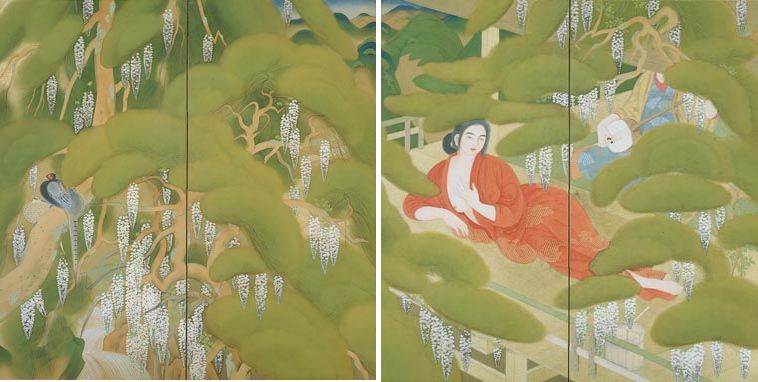
The National Museum of Modern Art, Tokyo Collection (main building) contains 14 items that have been designated by the Japanese government as Important Cultural Properties. These include nine Nihon-ga (Japanese-style) paintings, four oil paintings, and one sculpture. (One of the Nihon-ga paintings and one of the oil paintings are on long-term loan to the museum.)
The following Important Cultural Properties are shown in this period:
■Yorozu Tetsugoro, Nude Beauty, 1912
■Kishida Ryusei, Road Cut through a Hill, 1915
■Tsuchida Bakusen, Serving Girl in a Spa, 1918
■Nakamura Tsune, Portrait of Vasilii Yaroshenko , 1920
◆Please visit the Important Cultural Property section Masterpieces for more information about the pieces.
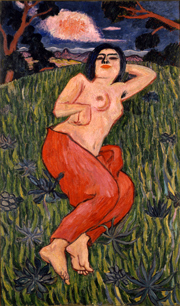
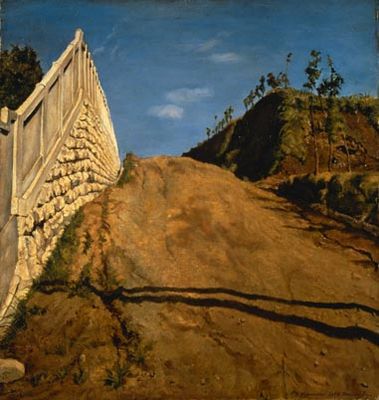
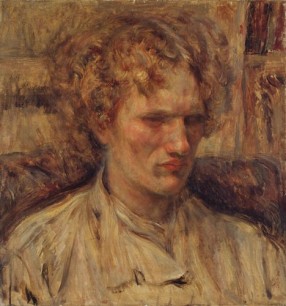
About the Sections
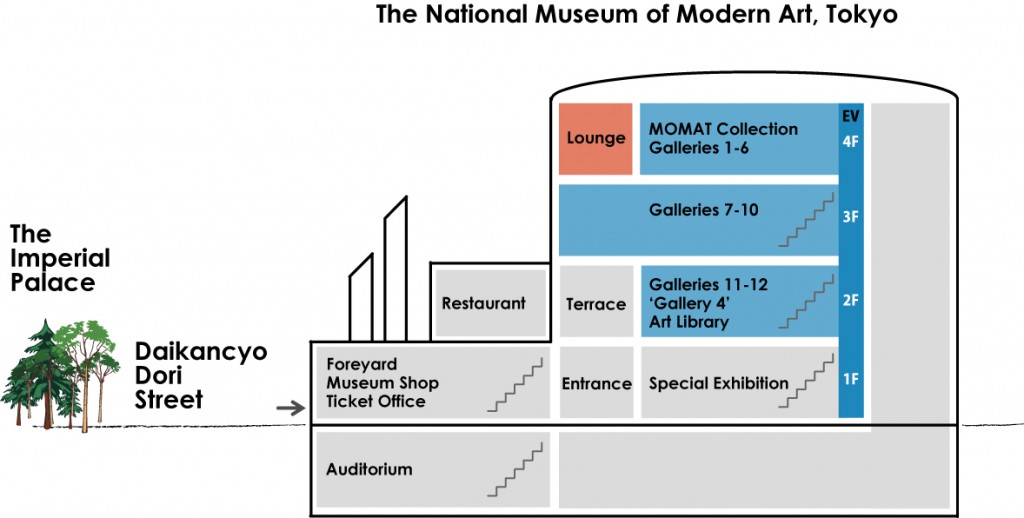
MOMAT Collection comprises twelve(or thirteen)rooms and two spaces for relaxation on three floors. In addition, sculptures are shown near the terrace on the second floor and in the front yard. The light blue areas in the cross section above make up MOMAT Collection. The space for relaxation A Room With a View is on the fourth floor.
The entrance of the collection exhibition MOMAT Collection is on the fourth floor. Please take the elevator or walk up stairs to the fourth floor from the entrance hall on the first floor.
4F (Fourth floor)
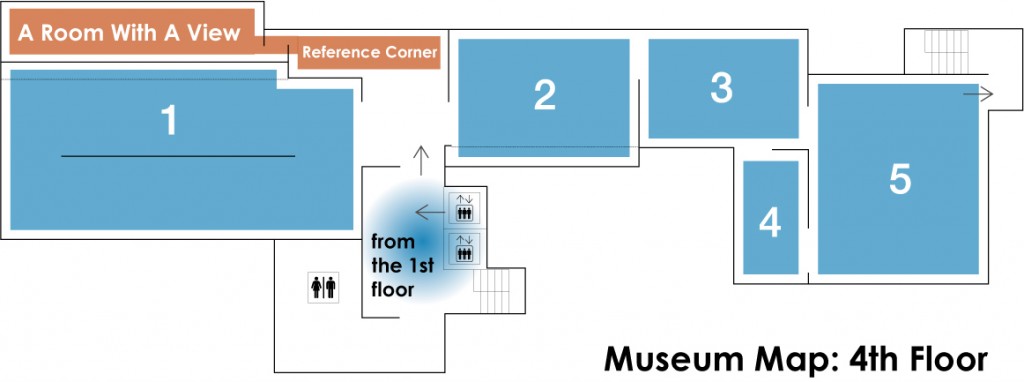
Room 1 Highlights * This section presents a consolidation of splendid works from the collection, with a focus on Master Pieces.
Room 2– 5 1900s-1940s
From the End of the Meiji Period to the Beginning of the Showa Period
A Room With A View
Reference Corner
Room 1 Highlights

Over 200 works are lined up in this 3,000-square-meter space – these extravagant conditions are the selling point of the MOMAT Collection. But in recent years, we have received an increasing number of comments like, “They’re so many things here, I’m not sure what to see!” and “All I want to do is have a quick look at the famous works in a short period of time!” Thus, in conjunction with the gallery renovation in 2012, we have created this “Highlights” corner to allow visitors to enjoy a consolidation of splendid works from the collection, with a focus on Important Cultural Properties. For the walls, we have selected navy blue to make the works stand out more beautifully. And to eliminate the glare of glass cases, we have opted for a mat black for the floor to help viewers concentrate on the displays.
We begin this edition with two screens that are perfect for early to midsummer: Kaburaki Kiyokata’s Boating Excursion on the Sumida River depicts a lively pleasure-boat trip, and Tsuchida Bakusen’s Serving Girl in a Spa expresses the vitality of human life as it competes with that of plants. The oil painting section includes foreign artists such as Paul Cézanne and Georges Braque, both of whom exerted an enormous influence on 20th century art. These paintings are followed by Important Cultural Properties by Yorozu Tetsugoro and Kishida Ryusei, and in the postwar category, works by Kusama Yayoi, Tanaka Atsuko, Tatsuno Toeko, and Nara Yoshitomo.


Room 2 Brilliant Light
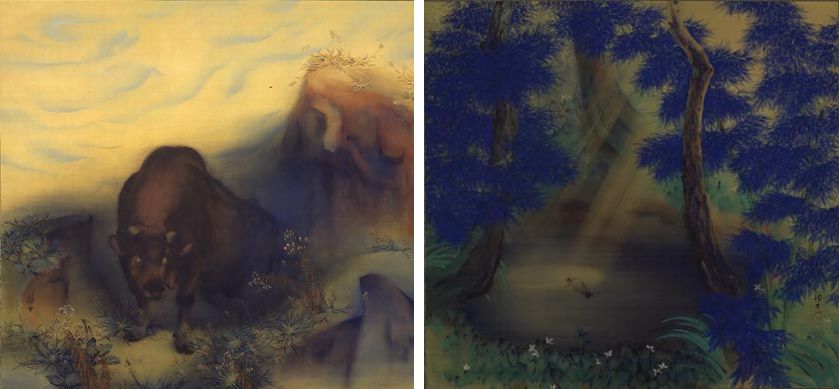
ⒸMinami Kawabata & Ryuta Kawabata 2016/JAA1600076
Summer is finally upon us. In this brilliant season, the mountains, rivers, and seas are bathed in sunlight. Artists of the Meiji and Taisho Period frequently depicted these types of landscapes that conveyed the summer light.
The woman in Nakazawa Hiromitsu’s Summer is shown under the shining sun. It would actually be difficult to sketch this kind of scene due to the backlight. Nakazawa, however, splendidly consolidates the women’s form, exuding a cool sensation with the underlying blue color.
While Kawabata Ryushi depicts living things bathed in peaceful light in his Nihon-ga (Japanese-style painting), Tokuoka Shinsen focuses on a lotus glistening in the mist of an early morning rain. In Tobari Kogan’s Woman Gazing at the Surface of the Water, the protagonist seems to be staring at the reflection of her own face. As you look at these works, try to imagine how each artist dealt with the light as they created the landscape.
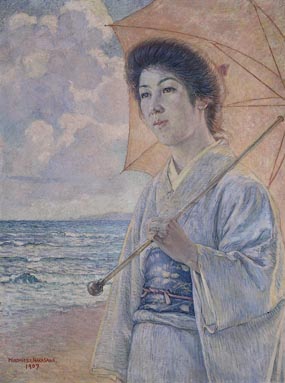
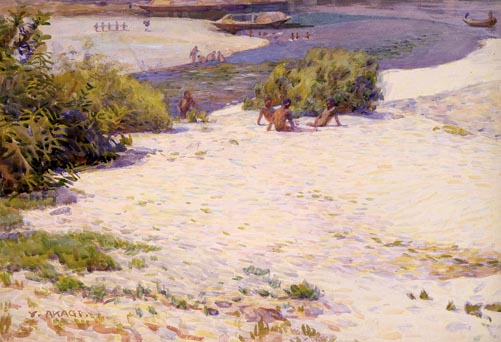
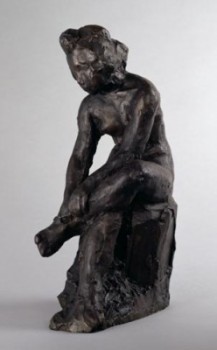
Room 3 Love and Cream Buns
Established in 1901, the bakery Shinjuku Nakamuraya is still headquartered in the Shinjuku district of Tokyo. Its founders, Soma Aizo and his wife Kokko, loved the arts and many young artists gathered at the bakery. These included sculptors such as Ogiwara Morie, Nakahara Teijiro, and Tobari Kogan, and painters such as Nakamura Tsune and Yanagi Keisuke. Perfectly conveying the freedom of the period, associated with so-called “Taisho democracy,” Nakamuraya was one of the era’s most important art salons.
The art salon concept originated in Europe, and its most significant feature was an attractive proprietress who discovered talented people. At Nakamuraya, Soma Kokko fulfilled this role. Ogiwara Morie was in love with Kokko and his work Woman is said to be based on her appearance. For his part, Nakamura Tsune fell first for Kokko and then later for the Somas’ oldest daughter, Toshiko. In both cases, however, his love went unrequited. As these examples suggest, in art salons during the Taisho democracy era, love was an important source of nourishment for art. So what about cream buns? In 1904, Nakamuraya became the first shop in Japan to make the baked delicacy.
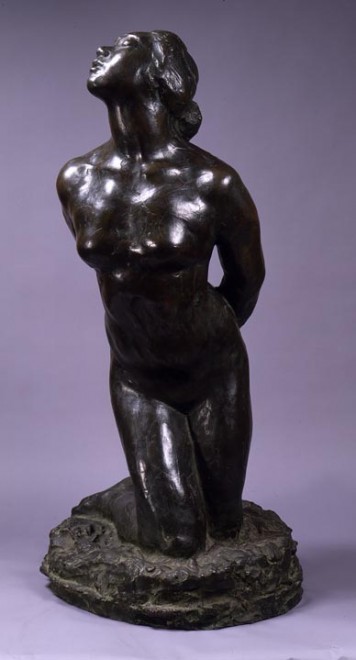
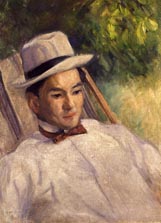
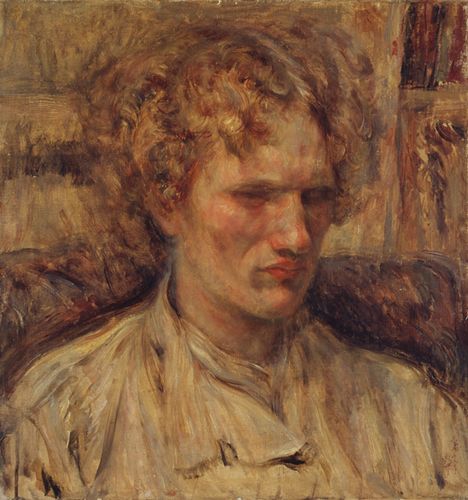
Room 4 Writhing Season
The word “writhing” in the title connotes two things. The first is mental agony. The sculptures on view in this room were made by artists such as Ogiwara Morie, Takamura Kotaro, Tobari Kogan, who were associated with the Nakamuraya Salon introduced in Room 3. Ogiwara, who was in love with Soma Kokko, proprietress of the salon, suddenly died at the age of 31 after completing Woman (on display in Room 3). Priest Mongaku (also on display in Room 3) deals with a Buddhist priest from the Kamakura Period who is said to have entered the priesthood after falling in love with the wife of one of his compatriots.
The title’s second connotation is physical agony – not merely emotional distress, but the violently twisted bodies seen in these works. Until the late 19th century, Japanese sculpture was characterized by figures that stood at attention. Ogiwara, however, introduced a trend of forms twisted in a spiral shape. This was rooted in his fondness for the work of the French sculptor Auguste Rodin. Despite the fact that the figure’s limbs have been omitted from the work, Rodin’s Torso conveys the twisted state of an entire body using only a torso.
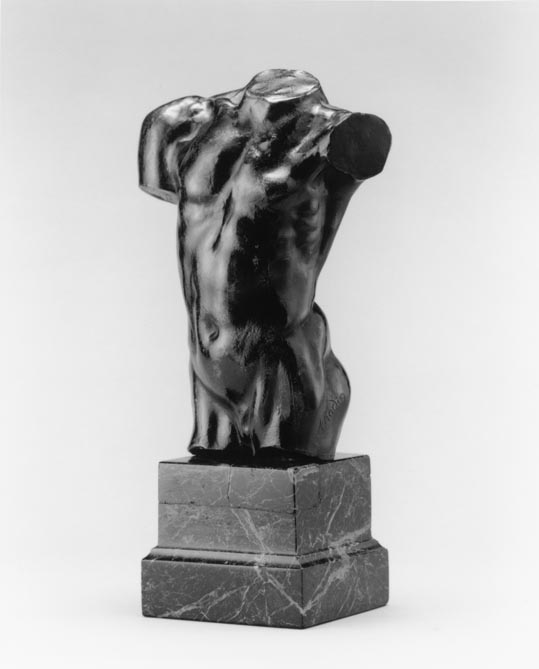
(Photograph:Otani Ichiro)
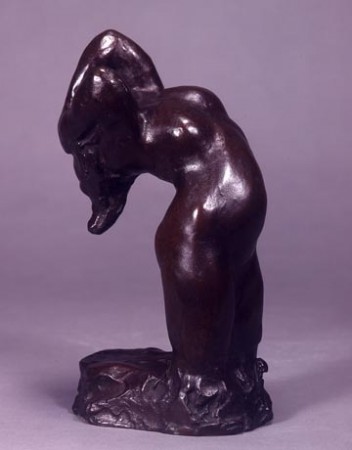
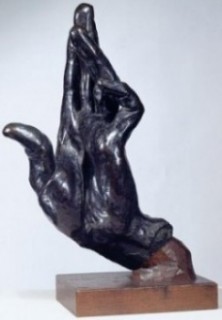
(Photograph:Otani Ichiro)
Room 5 There’s a Reason for Gathering Together
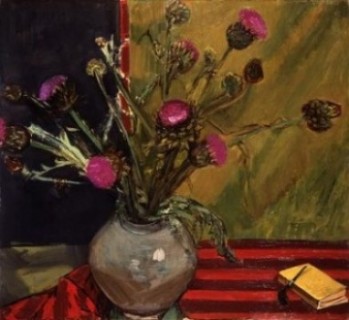
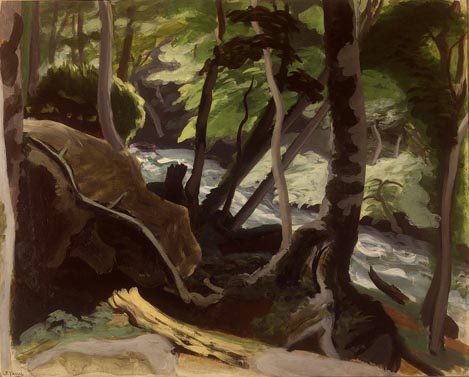
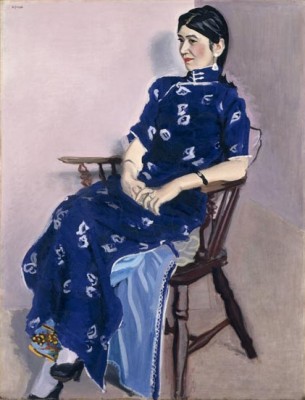
Portrait of Chin-Jung,1934
Fujishima Takeji, Umehara Ryuzaburo, Yasui Sotaro, Ihara Usaburo, and Ito Ren: The works you see here are by some of the most prominent artists of the 1940s. Yasui and Umehara, for example, are so well known that they inspired the term “Yasui / Umehara era.” Ihara served as a judge in the Teiten (Imperial Academy of Art Exhibition) in 1935, and Fujishima was awarded the first Order of Culture in 1937. Ito was recognized for his work with a prize at the Nika-ten exhibition in 1930 among other honors.
These artists took part in an event titled the “Works by Exceptional Children Roundtable Discussion,” held in 1939, a transcript of which was published the following year in the art magazine Mizue. The “exceptional child” under discussion was Yamashita Kiyoshi (1922–71), who is still known by the epithet, “the Wandering Artist.” Based on the fact that the five artists are joined by the Nihon-ga painter Kawabata Ryushi, the art critic Araki Sueo, the philosopher Tanigawa Tetsuzo, the psychologist Togawa Yukio, and Mizue’s editor-in-chief Oshita Masao, it is clear that Yamashita’s emergence in the art world was seen as an important event.
3F (Third floor)
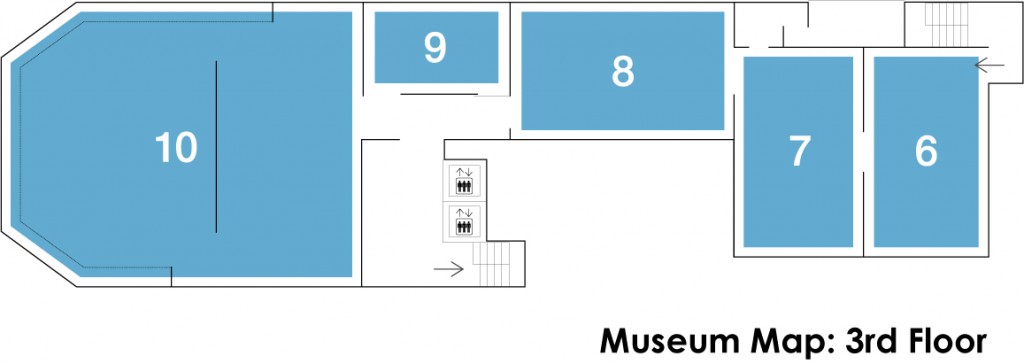
Room 6-8 1940s-1960s
From the End of the Meiji Period to the Beginning of the Showa Period
Room 9 Photography and Video
Room 10 Nihon-ga (Japanese-style Painting)
Room to Consider the Building
Room 6 Matsumoto Shunsuke: During and After the War
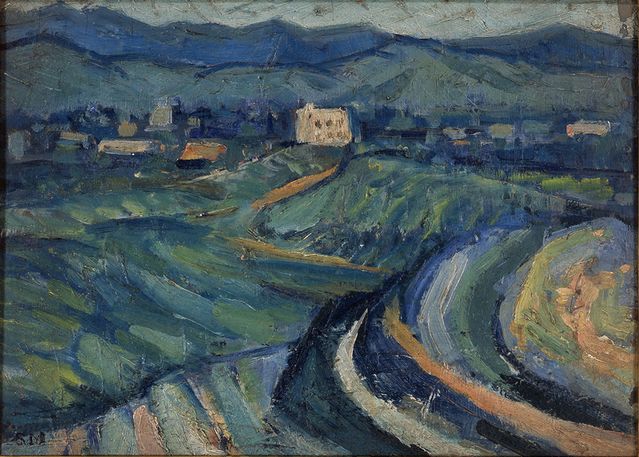
The Town of Sanno,1933
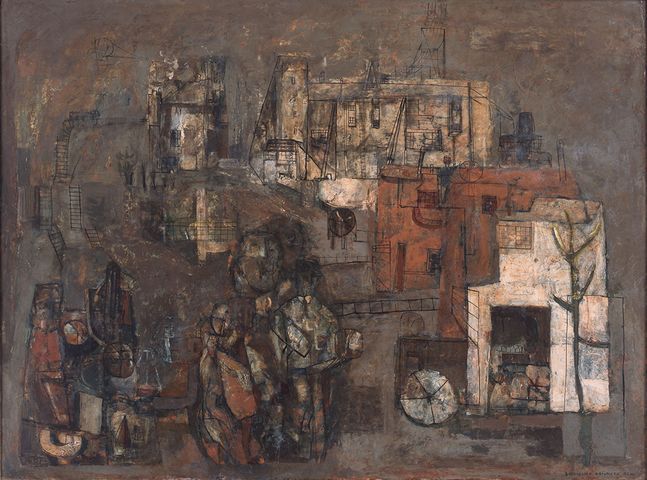
Scene near N Station ,1940
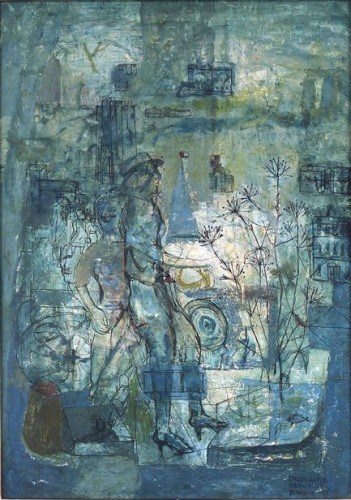
Black Flowers ,1940
Last year the museum acquired a group of 11 works (six oil paintings and five drawings) by Matsumoto Shunsuke. Combined with other works by Matsumoto that were already part of the collection, the museum now includes a total of 22 items, ranging from an early painting titled The Town of Sanno (1933) to the artist’s last work, Building (Brown) (1948), allowing viewers to trace the development of Matsumoto’s career. In this exhibit, we present all 22 of the works in this room and Gallery 4 (2nd floor) alongside Modern Landscapes – For the Pleasure of People and Scenery: Nara Yoshimoto Curates the MOMAT Collection.
Two of the new acquisitions, Scene near N Station and Black Flowers, were first shown in the avant-garde art group Kyushitsu-kai’s second exhibition in 1940, and are distinguished by the use of a montage technique combining a town and people. However, it was not new techniques that concerned Matsumoto so much the existence of the individual, whose existence was threatened by the masses of people in the city. Unlike the era’s war paintings, which were created for the nation and the masses, Matsumoto focused on the irreplaceable individual. This attitude is also consistently evident in the artist’s postwar artistic experiments.
Room 7 Ebihara Kinosuke, Chokai Seiji, and Jean Dubuffet
Born in Kagoshima Prefecture, Ebihara Kinosuke moved to France at the age of 18. After receiving acclaim in Paris, he moved to Kumamoto following the war and energetically devoted himself to art. Here, for the first time in quite a while, we have assembled several of the artist’s most notable works. In addition to Sleeping Sisters, the painting that led to Ebihara’s recognition in Paris, the museum collection includes works such as Skiing Ground, notable for the color of the sky, which inspired the term “Ebihara blue,” and Rainy Day, one of the reasons the artist received the Minister of Education Award for Fine Arts in 1964.
Along with these items, we present some works by Chokai Seiji, who like Ebihara was a member of the Dokuritsu Bijutsu Kyokai (Independent Art Association), and some by Jean Dubuffet, who like Chokai strove to express the ground using the texture of his canvases.
Room 8 Swinging and Swaying
Along with a design movement that attempted to revolutionize daily life, abstract painting, which emerged in Western Europe in the 1920s and ’30s between World War I and II, set out to renew the 20th century’s aesthetic sensibility. Established in Weimar, Germany in 1919, the Bauhaus, a comprehensive educational facility that strove to unify art and technology, counted artists like Wassily Kandinsky and Paul Klee among its teachers.
While referencing music and plant growth, the artists’ abstract paintings are distinguished by dynamic structures made up of colors and forms. In light of the fact that Alexander Calder’s kinetic sculptures, which he called “mobiles,” emerged during the same period, it is clear that movement in art was believed to contain new potential to create dialogue with the viewer and an interactive relationship with the surrounding environment.
Similar work began to flourish all over the world in the 1950s. While absorbing the ideas of Bauhaus and the art of Klee and Calder, Yamaguchi Katsuhiro and Kitadai Shozo, members of the Japanese art group Jikken Kobo (lit., “experimental workshop”), which was formed in 1951, crafted unique and dynamic images through their use of new materials like glass and aluminum.
Room 9 Windows and Photography
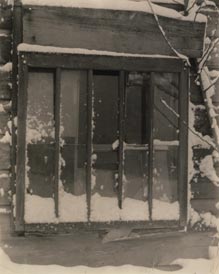
A window is an opening installed in the wall or roof of a building to provide lighting or
ventilation. As it is a familiar part of our lives, the word is used in a variety of metaphors and idioms such as “window on the world,” “the eyes are the windows of the soul,” “out the window,” and “window of time.” What sort of part do windows play in photography?
Windows, passages for light and vision, are highly compatible subjects for photography, a visual medium based on the apprehension of light, as is clear from the 20 works in this exhibit. Jaroslav Rössler’s Skylight, for example, simply captures the beauty of light pouring down into a room through a skylight, but that alone is deeply attractive. Meanwhile, Yasui Nakaji and Ohtsuji Kiyoji’s works, which provide us with a glimpse of something from a window, convey the fact that in its role as an opening that connects the inside and outside of a building, a window functions like a stage set producing dramatic effects.
Incidentally, the word “camera” is derived from the Latin word for “room.” Thus, the lens, which allows light inside a camera, is akin to a window. With this in mind, it makes perfect sense that windows are important motifs in photography.
Room 10 Season of Fragrant Breezes
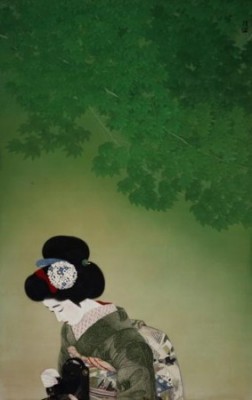
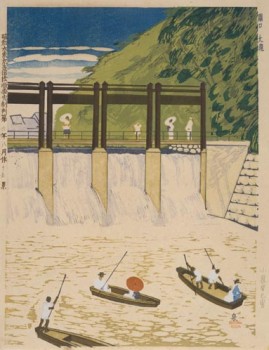
In selecting works with a seasonal theme for the first time in quite a while, we have assembled a group of works, which, by virtue of the fact that they are Nihon-ga (Japanese-style painting), are perfectly suited to summer. The title of this section is “Season of Fragrant Breezes.”
As one Japanese idiom would have it, May is a month of fresh breezes. But in referring back to Japanese literature, fragrant breezes have not always been associated with May. This is also clear, for example, from a poetic exchange between Emperor Wenzong (809-840) and Liu Gongquan (778-865) that dates to Tang-dynasty China. In this exchange, the term “fragrant breezes” referred to the winds of midsummer. And to return to Japan, the Heian-era poet Fujiwara Yoshitsune (1169-1206) used the term in a waka poem to refer to cherry blossoms in spring (“The day has again come when the cherry blossoms come into view / In my hometown, the flowers are illuminated by the moon through the trees / As fragrant breezes carry their fragrance through the trees”), and also in one about summer oranges (“The wind carries the fragrance of oranges to the eaves / As the years pass, oranges and hare’s-foot ferns always arrive together / Calling up images of the past.”). How about haiku? Masaoka Shiki’s poem, “Fragrant winds and pine shadows on naked forms,” is set on the island of shima in Ehime Prefecture, and the distinct shadows cast on naked men are so dazzling that they fit in perfectly with the fragrant breezes of early summer.
How do Nihon-ga painters depict the radiant period from early to midsummer?

ⒸMinami Kawabata & Ryuta Kawabata 2016/JAA1600076
2F (Second floor)
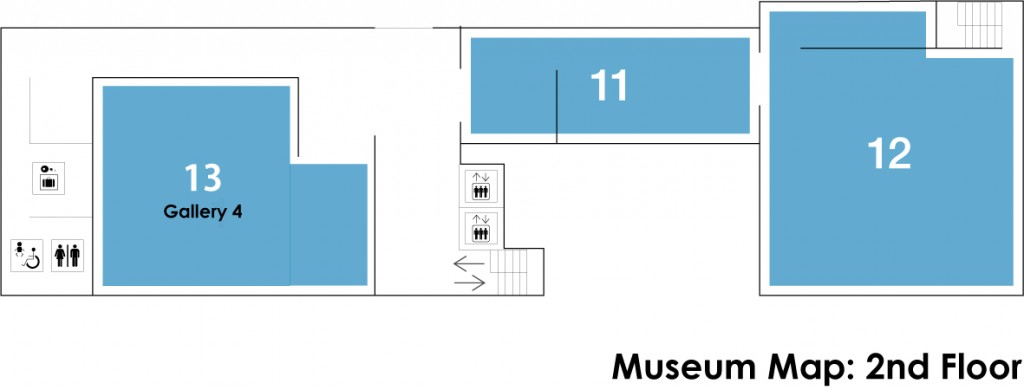
Room 11-12 1970s-2010s
From the End of the Showa Period to the Present
Gallery 4
* A space of about 250 square meters. This gallery offers cutting-edge thematic exhibitions from the Museum Collection, and special exhibitions featuring photographs or design.
Modern Landscapes – For the Pleasure of People and Scenery
Nara Yoshitomo Curates the MOMAT Collection
May 24-November 13, 2016 (except August 8-August 15, 2016)
Room 11 Signs of Life
Photography is an ideal medium for exploring and documenting everyday scenes that do not contain a particularly beautiful view or notable event. This is because our environment is our reality and the things that we come into contact with on a daily basis are the elements that make up the world we live in. This viewpoint gradually emerged as a distinct movement after the initial search for new photographic visions had ended.
In this section, we present work by four contemporary photographers: Robert Adams, a pioneer in this type of photography; Thomas Struth, a German artist who meticulously documents city streets; and Seino Yoshiko and Katsumata Kunihiko, who are approaching the Japanese landscape with their own methodologies in the 2000s.
The title of this special exhibit is derived from the title of a photo book by Seino in which the photographer subtly responded with a unique sensibility to scenes that most of us would have overlooked, and attempted to discover signs of life in those places.
Room 12 Challenging Iron
Iron, which exists in abundance in the natural world, has not only provided a foundation for human civilization, but is also indispensable in sustaining human life as a component in our blood. Despite its prevalence in every aspect of our lives, however, iron’s history as an art material is relatively short. The earliest use of iron can be traced to the 1920s, when the Spanish artist Julio González (1876-1942) created sculptures by welding together pieces of the metal.
In this room, we present postwar works by Japanese artists who were both attracted to iron and engaged in battle with the material. Wakabayashi Isamu developed fresh sculptural spaces based on his singular imagination, as is evident from the artist’s sketches. Muraoka Saburo, meanwhile, strove to evoke the inherent physiology of iron by melting and cutting iron rods with a length of over ten meters. Tsuchitani Takeshi created open spaces by adding wrinkles and beating thin, light pieces of iron. And last but not least, after pounding lumps of iron with a hammer, Tawa Keizo drew out the metal’s brilliance by making its surface fluid. By coming in contact with various features of the material that we would not normally encounter in daily life, we come to understand the magic of iron, which has the power to drive sculptors mad.
About the Exhibition
- Location
-
Art Museum Collection Gallery, from the fourth to second floors
- Date
-
May 24, 2016 – August 7, 2016
- Time
-
10:00-17:00 (Friday and Saturday is 10:00-20:00)
*Last admission is 30 minutes before closing. - Closed
-
Closed on Mondays (except July 18) and July 19
- Admission
-
Adults ¥430 (220)
College and university students ¥130 (70)
*Including the admission fee for MOMAT Collection and Modern Landscapes – For the Pleasure of People and Scenery: Nara Yoshimoto Curates the MOMAT Collection.
*The price in brackets is for the group of 20 persons or more.
*All prices include tax.
*Free for high school students, under 18, seniors(65 and over), Campus Members, MOMAT passport holder.
* Show your Membership Card of the MOMAT Supporters or the MOMAT Members to get free admission (a MOMAT Members Card admits two persons free).
*Persons with disability and one person accompanying them are admitted free of charge. *Members of the MOMAT Corporate Partners are admitted free with their staff ID. - Free Admission Days
-
Collection Gallery and Gallery 4
Free on June 5, July 3 and August 7, 2016 - Organized by
-
The National Museum of Modern Art, Tokyo


